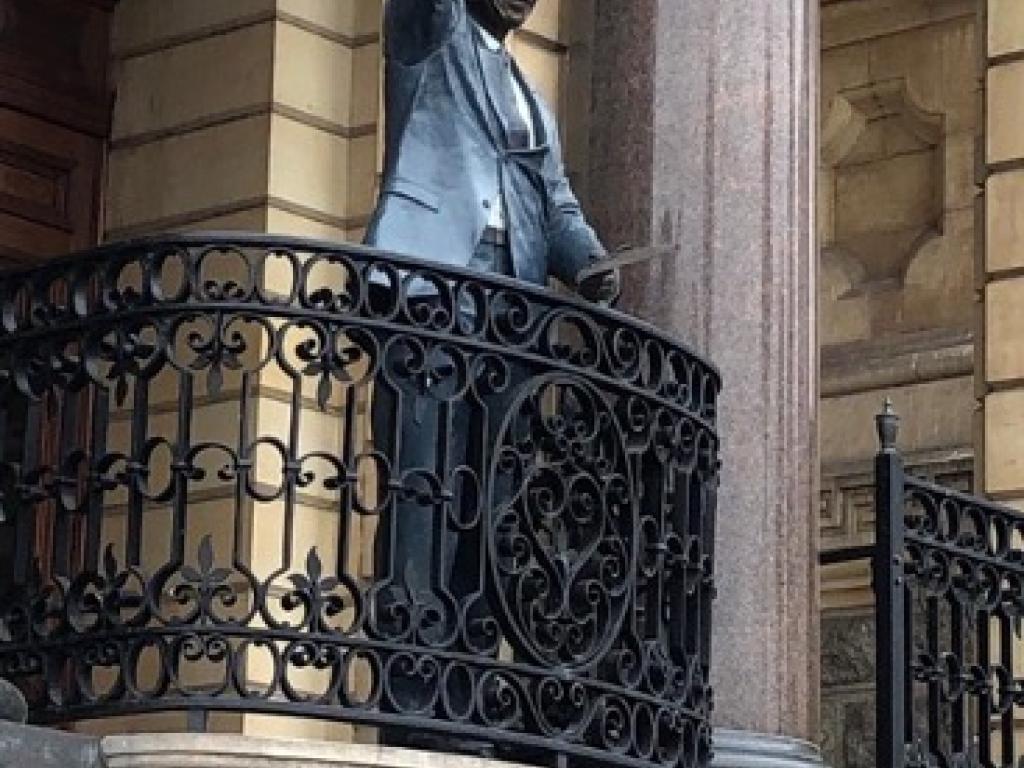Facing Down the Coloniser?

Cynthia Kros
My chapter ‘Facing (Down) the Coloniser? The Mandela Statue at Cape Town’s City Hall’ was published in September 2021 in a book with the wonderfully evocative title Falling Monuments Reluctant Ruins: The persistence of the past in the architecture of apartheid edited by Hilton Judin, a member of the academic staff in the School of Architecture and Planning at Wits University. The book is the first product of a series of workshops (jointly hosted by Judin’s School and the History Workshop also at Wits) focused on the material residues of apartheid/colonialism. ‘Facing (Down) the Coloniser?’ was based on research inspired by the installation of a more or less life-size bronze statue of Mandela on a balcony at the City Hall in the month and year, July 2018, in which he would have turned 100. When the plan to create and install the statue was approved, the ANC leader in the Council, Xolani Sotashe, objected that it would mean forcing Mandela to look at the statue of Edward VII embodying everything Mandela had opposed, directly opposite the balcony on the Parade below. The marble statue of the king erected in the early twentieth century not long after his coronation is gigantic at two and a half metres tall in itself, standing on a plinth that is three metres in height.
Before the Mandela statue was installed, the author, on wandering around the site, had been struck first by how low the balcony is above ground level and secondly by the realisation that when Mandela had made his first public speech almost immediately after his release from prison on 11 February 1990 from the self-same balcony, the immense statue of Edward VII must have been directly in his line of sight. Hence, the first question that occurred to the author was of the same order as Sotashe’s objection. Did a modest, life-size statue of Mandela have a chance of facing down the coloniser? More questions followed swiftly. Why was Mandela chosen by the Democratic Alliance, the Party that governed the City and was in opposition to the ANC? And why was Mandela chosen when large swathes of public opinion seemed to suggest that his popularity was waning and being replaced by disillusionment and anger at what was widely seen as his betrayal of the movement and a fatal readiness to make compromises in the cause of a negotiated settlement? The answers are complicated.
The notion of statue mania under the Third Republic in France which followed the collapse of the Second Empire in the late nineteenth century, proposed by French historian Maurice Agulhon ( ‘La “statuomanie” et l’histoire’, Ethnologie Française 2/3, 1978, 145-72), proved to be valuable. He argued that the rash of statues of ordinary men as distinct from monarchs or saints that appeared in public places were supposed to inspire civic virtue to support the new republican ideology. There were certainly examples of that approach, voiced explicitly by City of Cape Town officials. However, Agulhon also made a distinction between ‘ideological’ and ‘political’, which proved particularly useful for this chapter on the statue of Mandela on the balcony of the Cape Town City Hall. It allowed the author both to argue for the broader strategies city officials adopted for mobilising citizens behind a particular vision of the City, sometimes reminding them of their putative duties as citizens, and to hint at more narrowly political ambitions harboured by some of the individuals concerned. The word ‘hint’ is used advisedly. The configuration of the City Council and, particularly the position of the Executive Mayor Patricia de Lille, was about to change radically in the course of the year the statue was installed. This vindicated the author’s sense that through her enthusiastic support for the statue, De Lille was articulating a broader national loyalty that would protect her from the consequences of her increasing alienation from her own Party — and she has since been appointed the national Minister of Public Works and Infrastructure, as well as holding the leadership position of the breakaway Party called Good. However, there is simply not enough evidence to ascribe her enthusiasm simply to expedience.
There was a distinct disadvantage to interviewing people who were responsible for, or involved with commissioning the statue, as the author did. It became much harder after examining their CVs and conversing with them about their broader social commitments, to write of the statue venture in the kind of cynical way that comes easily to academics, especially those who are critical of the City of Cape Town. The author kept recalling the words of poet Gabeba Baderoon, whose family was forcibly removed to the Cape Flats, spoken before she gave a reading of her poem ‘A Prospect of Beauty’ (published in The History of Intimacy: Poems, Cape Town, 2018) at UCT to the effect that Cape Town, much lauded for its beauty, is only beautiful for some. But, the city officials who were interviewed had no problem in assenting to that notion and saw themselves as contributing to the building of a more inclusive city. Also, for them, the power of Mandela’s moral authority was more than a match for the exaggerated stature of the marble king who towered over the Parade not far away. Furthermore, they said they believed it was important, as indeed a handful of the respondents to a public survey conducted to determine attitudes to the proposal made for the statue had pointed out, that the deeply colonial landscape be reshaped and the ‘public mind’ be provided with some other reference points for contemplation.
Cynthia Kros. 2021. ‘Facing (Down) the Coloniser? The Mandela Statue at Cape Town’s City Hall’. In Falling Monuments Reluctant Ruins: The persistence of the past in the architecture of apartheid edited by Hilton Judin, 234-255. Johannesburg: Wits University Press